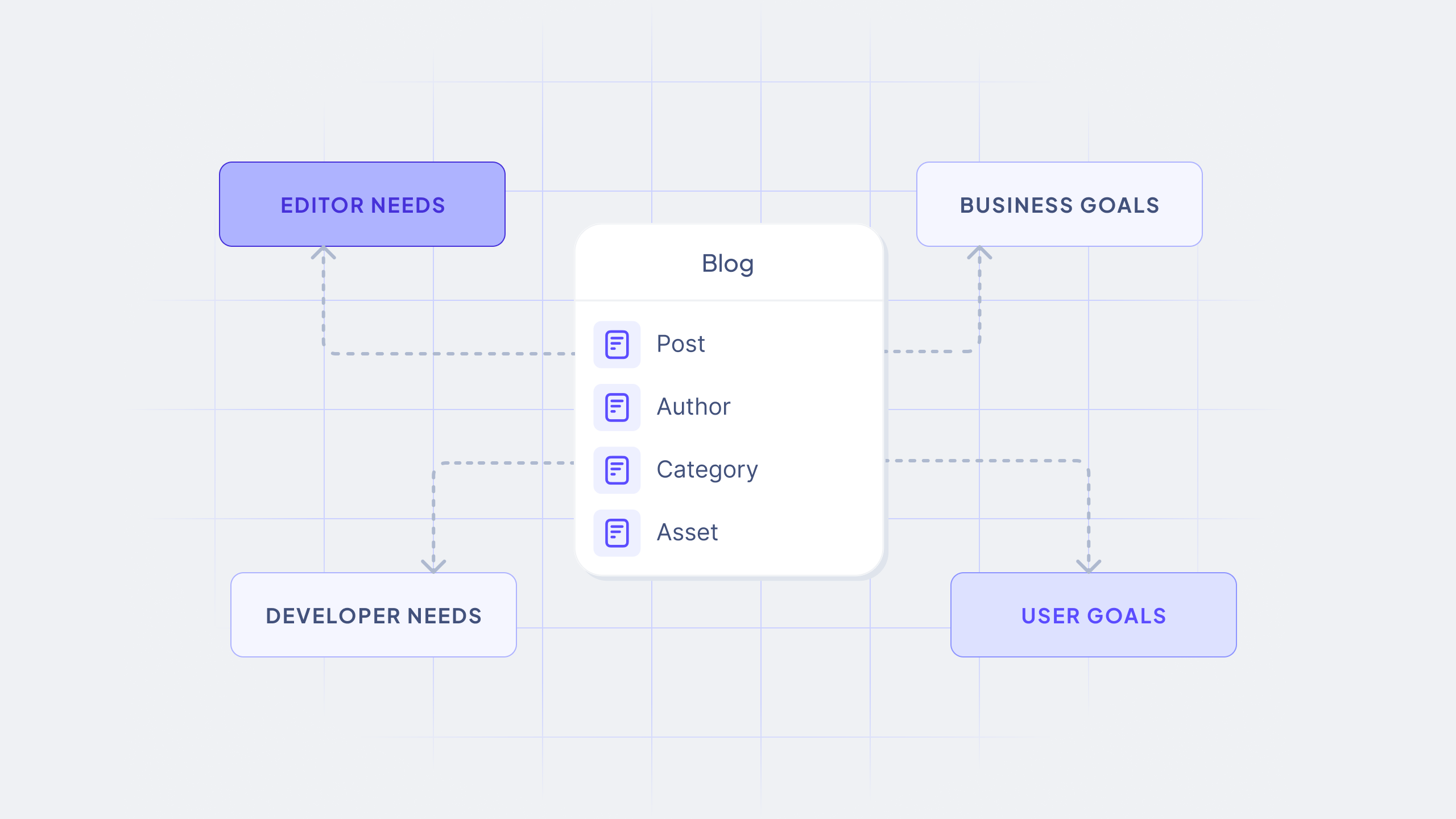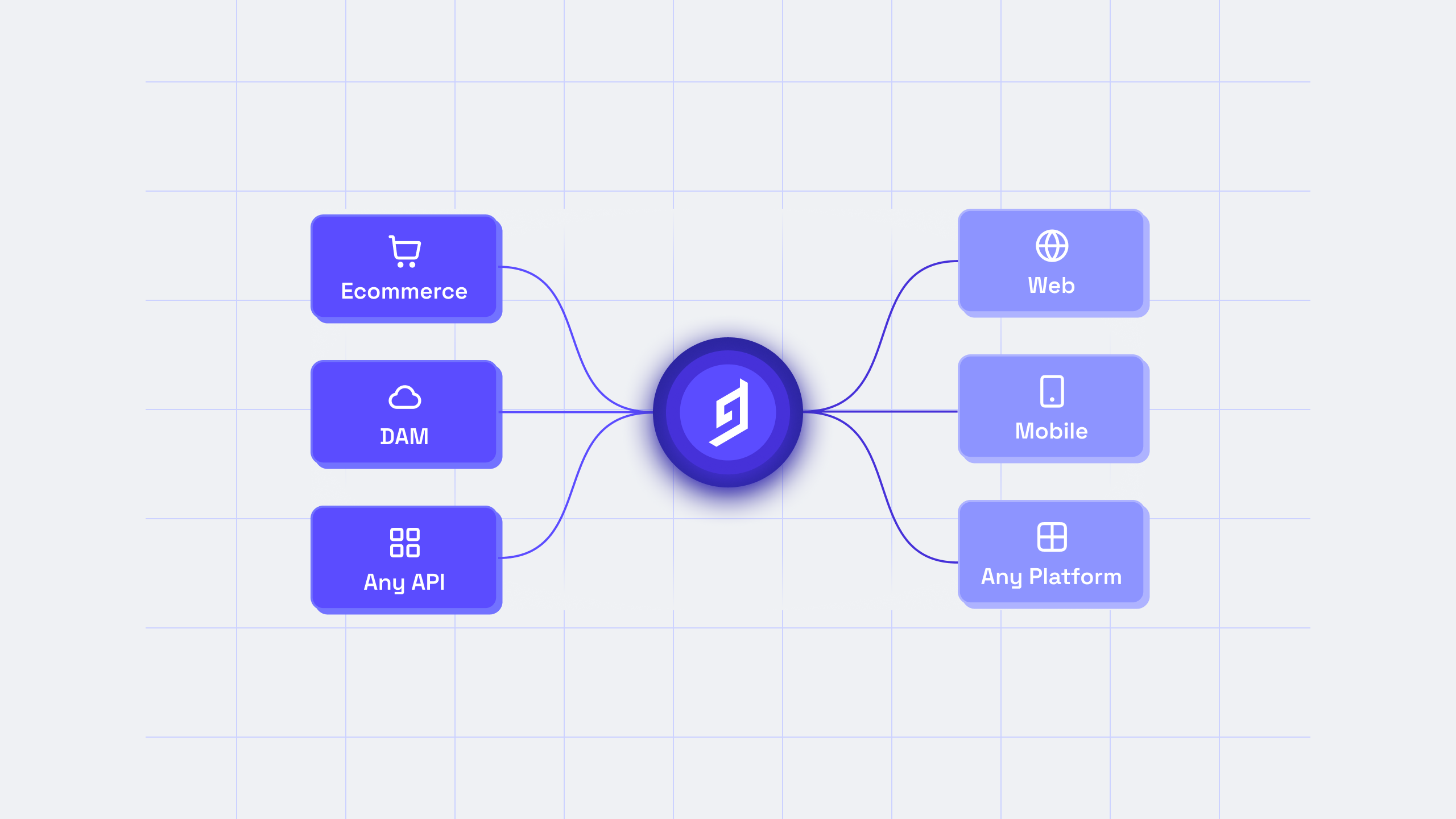Gartner coined the term composable business in 2020 to describe the trend of companies moving away from traditional architectures, where technology is locked into one way of doing things, and towards a modular structure that lets businesses change and replace technologies and services as needed.
The idea quickly gained traction. Both among technology leaders, with Gartner predicting that 70% of large and medium organizations will have composability as a key criteria for their new application planning by 2024. As well as among solution vendors, with Gartner predicting that the top 20 cloud platforms and software-as-a-service (SaaS) providers will offer composable component marketplaces by 2026.
#What is composable content?
Being a relatively new term, and a popular one, “composable” is used to talk about a few different ideas in the technology space. Primarily:
- Composable architecture: Unlike a traditional all-in-one platform where you’re locked into a certain set of capabilities, a composable architecture lets you choose interchangeable, best-of-breed tools and connect them all with APIs. A composable tech stack might include a mix of SaaS solutions, tools built in-house, and even legacy platforms wrapped in an API layer.
- Composable platforms: Solutions that specialize in one business domain, such as content, commerce, or search, and are designed to integrate their services easily with other technologies. Many of the leading composable platforms are built with MACH principles (microservices, API-first, cloud-native, headless) and it’s not uncommon to find a few MACH Alliance members involved in a composable strategy.
- Composable content: Structured content in modular blocks that can be used in multiple ways across different channels. Content is stored in a presentation-neutral way so that it can be adapted to any frontend “head” (i.e. headless content). An API-based structure makes it possible to enrich content from various data sources, drive automations, and create content models to fit unique customer needs.
#Why should businesses adopt a composable content strategy
As the digital world expands, so do people’s expectations. Customers want better experiences across more channels, and businesses want new ways to differentiate themselves. It’s nearly impossible for a suite of capabilities from a single vendor to meet every digital need of a company, much less the needs of multiple companies across different industries.
For a while, businesses dealt with this by building workarounds and integrations to their legacy monolith but all this customization made the cost of change incredibly high - and digital needs change quickly. Markets can shift, customer demands can emerge, or a global pandemic can disrupt everything, and it’s very risky to invest in a platform that isn’t able to adapt.
Composability gives businesses the flexibility to evolve and scale in any direction. Technologies can be quickly added or removed from a composable architecture, the services of different composable platforms can be mix-and-matched to solve new problems, and composable content can be used to quickly support new channels and experiences. As summarized in Gartner’s introduction to composable business:
The building blocks of composable business enable organizations to pivot quickly.
#4 steps to a composable content strategy
1. Get the right people in the room
A composable content strategy is all about structuring content for reuse and efficiency, so it’s important to collaborate with every team that’s involved in the end-to-end content process. Engineers, editors, designers, and business development stakeholders are all needed for insight into how content currently supports channels and users, long-term ambitions and extensibility, affected business processes, and the intended outcomes of content.
2. Break out of the page-builder mindset
The key difference between a traditional approach to content and a composable one is that composable content isn’t locked into a certain way of being displayed, but is stored presentation-neutral and sent via APIs to be delivered in many different ways across different channels.
Instead of thinking about content in terms of a full page template, think about how to break it down into reusable pieces. This could be a single asset like an image or pricing data. Or it could be a cluster of information like business terms, metadata, forms, or product attributes. How granular you go depends on business needs, and on finding the balance between content locked to a single channel and content that’s become so fragmented that it’s hard to put together in an efficient way.
3. Create structured content models
While business leaders envision a world in which their team can create content once and use it anywhere, reusable content is still relatively untapped. You might have thought of pushing the same content using modular blocks to both your website and mobile app, but how about letting content editors write email copy, connect them via API, and push it to your CRM, or having your marketing team develop campaign copy, then update it automatically on display ads?
Structured content models are the cornerstone of a composable content strategy. Define a set of reusable content models, the fields used to structure information in these models, and how the models relate to and reference one another. For a deeper dive into this process, check out our in-depth guide to composable content modeling.
Content models
These are the reusable blocks of information. A model can be a group of structured data that can be adapted to various presentation layers, like the “Company Wiki Project Schema” seen in the image below. Or it can be a set of instructions for how content is interrelated, such as web components or the “Employee Model” in the image below.
Fields
Fields are the pieces of structured information within the model. A field can be anything from plain text, Markdown, an image asset, calendar date, geo location, third party data, boolean data, to a piece of logic that pulls in data from other content models.
Fields can be used in many different ways depending on content purpose, industry standards, and business processes. The photo above is one example of content structure, with “Blog Post Model” having the fields “Title”, “Descriptions”, “Cover Image”, etc. For another example, have a look at how a car dealership uses fields to structure content.
References
For it to be easy to reuse models, teams need to outline how different models relate to one another. In the image above an author’s bio will only need to be created once using the “Author Model” and any blog she writes will simply reference her existing profile. In reverse, the “Author Model” can reference any related blog posts so that it would be easy to see all blogs she’s written. For another example, here’s how a learning platform sets up relationships between different levels of content.
4. Connect the data
Pull in data and services so that developers and content creators can easily work with it in one place. This includes data that your content models require such as information from an e-commerce platform, product inventory management (PIM), customer relationship management (CRM), weather data, maps, industry databases, etc. As well as connecting the tools in services in your tech stack that are needed for the content creation process such as marketing automation, testing, and translations.
Depending on the content platform being used, this may require custom integrations or middleware to manage data syncing. Hygraph uses content federation to simplify data management by joining data from all backend sources using a single GraphQL API. Data continues to live in the original source, with Hygraph acting as an API gateway that grabs the most up-to-date information directly from the source whenever it’s requested by internal users, customers, or automated systems.
#Benefits of adopting a composable content strategy
Consistent content, everywhere
Instead of copy and pasting content and data between multiple, siloed systems a composable approach allows you to unify data on the backend to deliver a consistent digital experience across all your frontend channels. With content federation, developers and content teams have access to all information in one place, and the API-based delivery means that when data is updated at the source it’s automatically updated everywhere it’s used. Giving teams the ability to scale content creation and use more complex data strategies with the peace of mind that content will always stay fresh.
Faster time-to-market
Breaking content into reusable building blocks makes it easier to spin up new ideas. Engineers can quickly create structured content models that meet the needs of multiple use cases, pulling in services from other technology solutions as needed. Content creators can then combine these models in a variety of ways to create unique experiences without custom development.
The most notable outcome was by breaking down the design into a component led content model structure. We now have essentially a box of lego blocks where we can create rich content pages quickly and easily and enable our content team to lean into their creativity.
Adapt and evolve with ease
Composable content is not tied to any particular channel, business process, or integration. It supports a composable approach to architecture where businesses can choose a technology stack of best-of-breed tools that can be interchanged as a business evolves. Composable content doesn’t require re-architecting every time the tech stack changes. Instead, individual content models can be quickly adapted to support new services and data sources as needed.
#It’s all about delivering impactful experience to your users
A composable approach allows you to structure content in the way that makes sense for your customers. Instead of adapting strategy to fit rigid templates or limited capabilities of a platform, businesses can start by defining the ideal customer experience and can then create unique content models to achieve that vision.
For instance, Samsung is using composable content to transition their loyalty program from a mobile-only app to a multichannel user platform. They’ve used unique content models to replicate model app features for web users, as well as a flexible architecture to deliver localized solutions that align with different regional requirements. This has led to an estimated 10% increase in new loyalty members, and a 15% increase in customer engagement.
The biotechnology publisher, BioCentury, leverages a composable approach to pull in data and content from multiple services and share that information in many different ways with clients. Flexible content models allow them to deliver academic articles, white paper, news, analysis, collections of research, visualizations of real-time data, and more with ease. Leading to 80% faster content publishing for their team and a 120% increase in content engagement among their audience.
#Composing your content with the next-generation content management solution
Hygraph is the next-generation content management platform designed for the era of composable architecture. Hygraph makes it easy for businesses to orchestrate content across unlimited use cases, backend data sources, and frontend channels by providing:
- Modern architecture: Leverage the flexibility of a natively headless, SaaS platform that exposes all content and functionality via a powerful GraphQL API.
- Content Federation: Join data from multiple sources using a single GraphQL API. Data lives in the original source, with Hygraph acting as an API gateway to provide access to always up-to-date information in one central place.
- Flexible content modeling: Structure content to fit exact business needs. An intuitive Schema Builder makes it easy to create models, set fields, and define relationships between models.
- Rich editing experience: Turn composable content into engaging experiences with an intuitive user interface that provides versioning, preview, digital asset management, and more.
- Friction-free collaboration: Unlock the operational efficiency of your team with flexible workflows, roles & permissions, and localization capabilities for global business.
Curious to learn how Hygraph could support your business strategy? Our content experts would be happy to help.
Blog Author


